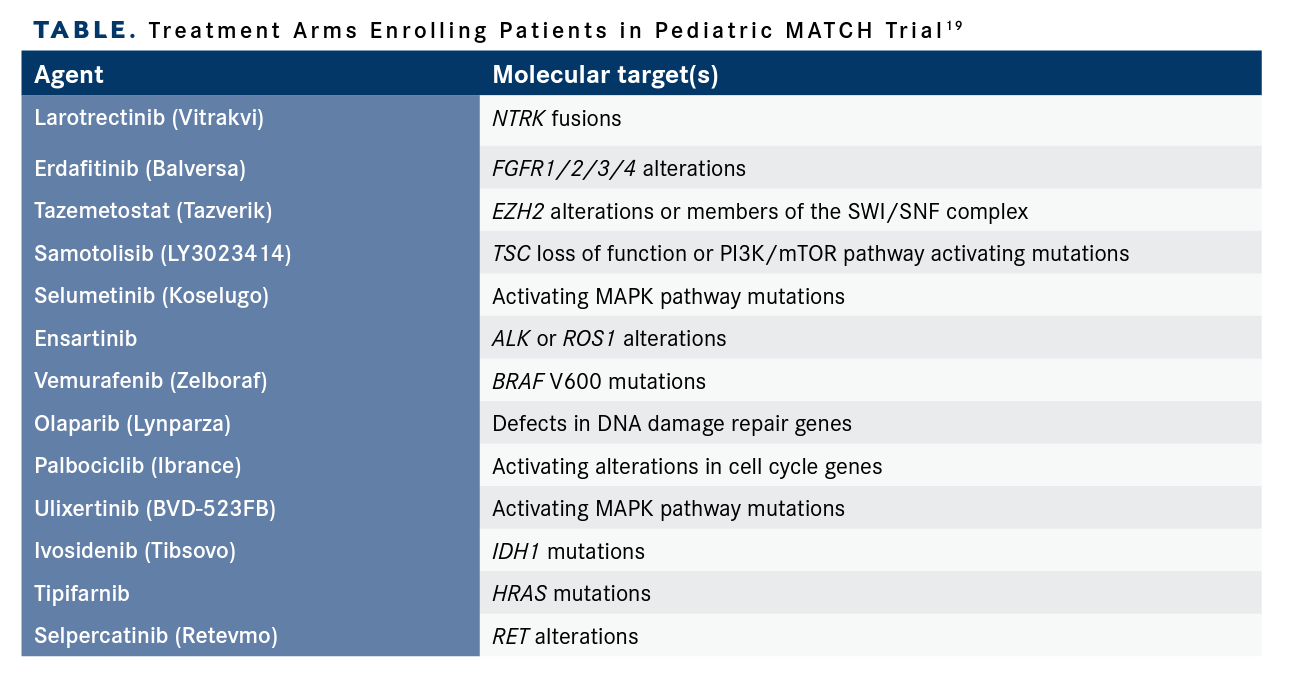Article
Surge of New Drugs Fuels Optimism in Pediatric Oncology
Author(s):
The landscape for pediatric oncology drugs expanded dramatically last year, with 8 new drugs or indications specifically approved for children compared with just 47 for treatment and supportive care products from the early 1950s through 2019.
Theodore W. Laetsch, MD

The landscape for pediatric oncology drugs expanded dramatically last year, with 8 new drugs or indications specifically approved for children compared with just 47 for treatment and supportive care products from the early 1950s through 2019.1,2
The roster of 2020 therapies includes a rare example of a pediatric-only agent, selumetinib (Koselugo), which was approved for neurofibromatosis type 1 (NF1) with inoperable plexiform neurofibromas (PNs), as well as treatments for thyroid cancer, Hodgkin lymphoma, neuroblastoma, acute myeloid leukemia (AML), epithelioid sarcoma, and tumor mutational burden (TMB)–high solid tumors. This year began with additional progress: On January 14, 2021, the FDA approved a new indication for crizotinib (Xalkori) for patients 1 year and older and young adults with relapsed or refractory systemic ALK-positive anaplastic large cell lymphoma.3 (TIMELINE2)
Pediatric oncologists attribute the burst of approvals to advances in genomics and immunooncology that have sped up development of targeted therapies, an increasing willingness to treat adolescents with drugs approved for adults, and regulatory efforts such as the Creating Hope Act of 2012, which gives incentives to pharmaceutical companies to develop pediatric treatments. The pace of approvals is expected to increase further thanks to the Research to Accelerate Cures and Equity (RACE) for Children Act, which requires drugmakers to investigate potential pediatric applications of new targeted therapies. The act, signed into law in August 2017, went into effect in August 2020.4
“Those incentives are really starting to align to encourage pharmaceutical companies to support pediatric studies and are driving this forward. We’re starting to see some of the results from that,” said Theodore W. Laetsch, MD, a pediatric oncologist who leads the Developmental Therapeutics Program and Very Rare Malignant Tumors Program at Children’s Hospital of Philadelphia in Pennsylvania. He also heads the rare tumor disease committee of the Children’s Oncology Group (COG), a National Cancer Institute (NCI)–supported clinical trials collaborative.
“The FDA is paying very close attention from the start of drug development. It’s helped a great deal,” said Elizabeth Fox, MD, MS, senior vice president for clinical trials research and associate director for clinical research at the Comprehensive Cancer Center of St Jude Children’s Research Hospital in Memphis, Tennessee. Thanks to the RACE for Children Act, “we are seeing a lot of interest from pharmaceutical companies in discussing what trials can be done in kids and how. It is achieving its initial goal— to start the conversation. Pharmaceutical companies are also starting to do basket trials for children. That is great for potential access to drugs.”
TIMELINE. Recent FDA Approvals for Pediatric Indications2

Shared Targets for Adults and Children
Pediatric-specific drug development has been uncommon in the past because childhood cancers make up less than 1% of malignancies diagnosed annually in the United States,5 and the market for such drugs is comparatively smaller than it is for adult indications, experts say. In 2020, the incidence of cancers was estimated at 11,050 for children younger than 15 years and 5800 among those aged 15 to 19 years.5
Donald Williams Parsons, MD, PhD

Although the FDA has approved fewer therapies for pediatric patients than for adults, the number of drugs indicated for children and teenagers has been growing as a result of federal legislation to promote development, starting with a 1997 law enacting a pediatric exclusivity provision, FDA officials said in a review published in Pediatric Blood & Cancer.1
From 1953 to 2019, the FDA approved 34 drugs covering 38 indications for treating childhood cancers and an additional 6 therapies for preventing or mitigating adverse effects.1 In 2019, that total grew by 3, with the approval of entrectinib (Rozlytrek) for adults and children with NTRK fusion–positive tumors; ruxolitinib (Jakafi) for adults and children 12 years and older with graft-versus-host disease; and an expanded indication for dalteparin sodium (Fragmin) for treating symptomatic venous thromboembolism in pediatric patients based on pivotal data that included participants with active cancers.2
One barrier to developing pediatric oncology drugs has been the exclusion of young patients from studies over concerns that an approval could be derailed if a child were harmed in the trial, Laetsch said. Those concerns turned out to be overblown, he said.
Further, with the field of precision medicine rapidly expanding, investigators have recognized that the same molecular drug targets were often present in both adult and pediatric cancers, said Donald Williams Parsons, MD, PhD, deputy director of Texas Children’s Cancer and Hematology Centers in Houston and COG study chair for the NCI-COG Pediatric MATCH study (NCT03155620). “There’s this recognition that it doesn’t make much sense for a company to be studying exclusively adults, if they have a target that’s also in children, for their financial self-interest and if they’re trying to identify rare groups. That’s a rare group—the kids—and one they can target,” Parsons said.
The approval of larotrectinib (Vitrakvi) in November 2018 for patients with NTRK fusion–positive solid tumors was a major step in efforts to boost the development of pediatric drugs. Although NTRK fusions are rare in cancers overall, they occur more frequently in some pediatric tumors, including 95.5% of infantile fibrosarcomas.6 Trial investigators recruited both adults and children early on and created an oral liquid formulation for the youngest patients.
“Almost one-third of the patients in the data set [N = 55] that was submitted to the FDA for approval were children. That’s really unusual for a drug that’s being approved for adult cancer. That highlighted to people involved in drug development that this can [not only] accelerate the pathway for children, but also get the drug approved for adults,” said Laetsch, who was lead author on the SCOUT trial (NCT02637687), 1 of 3 studies whose findings paved the way for the decision.7,8
Elizabeth Fox, MD, MS

“As pediatric oncologists, that’s what we’re looking for, but that is going to be a very rare find,” Fox said of larotrectinib’s development. “It requires real collaboration between pharmaceutical companies, medical oncologists, and pediatric oncologists because there are things you have to consider when you are treating children on clinical trial that are different from adults. Simple things like organ function is very different, how you dose the patient is very different. If you can consider those up front, you can probably write a better trial.”
The development of selumetinib similarly demonstrated how molecular targeting broadens potential uses for an investigational agent. The MEK inhibitor previously had disappointing results in adult trials for non–small cell lung cancer (NSCLC), metastatic uveal melanoma, and thyroid cancer.9 Then the drug came to the attention of NCI investigators who for years had been studying potential treatments for NF1, a rare genetic disease that can lead to PNs and aggressive, malignant neural tumors.10
In 2011 they tested selumetinib in children with NF1 with PNs and observed tumor shrinkage. In the subsequent SPRINT phase 2 stratum 1 trial (NCT01362803) involving 50 children aged 3.5 to 17.4 years, the overall response rate (ORR) was 66% (95% CI, 51%-79%), comprising all confirmed partial responses, which lasted 12 months or longer for 82% of the responders.11 The FDA approved the drug for patients 2 years and older with NF1 who have symptomatic inoperable PNs and awarded AstraZeneca a voucher that can be used for a subsequent priority review for successfully developing a rare pediatric disease product.12
Like larotrectinib, selumetinib is an example of a narrowly targeted drug successfully matched to a small group of pediatric patients with an unmet need, Parsons said. NF1 “is a bad clinical problem for kids, and it’s a pretty specific population of patients,” he said. “Neurofibromatosis is a relatively common genetic disease by genetic disease standards, but by any other standards, it’s a rare disease. It’s a tumor type without other good available therapies, so specific trials were designed for those patients using the drug based upon the clinical research in that group.”
The FDA also awarded a priority review voucher to Y-mAbs Therapeutics, Inc, for developing naxitamab-gqgk (Danyelza), an anti-GD2 monoclonal antibody for the treatment of patients 1 year and older with relapsed or refractory high-risk neuroblastoma who have experienced a partial response or stable disease after prior therapy. The voucher was sold for $105 million in December 2020, a month after naxitamab was granted accelerated approval for use in combination with granulocyte-macrophage colony-stimulating factor (GMCSF) for this patient population.13,14
In the phase 1/2 study 12-230 trial (NCT01757626), naxitamab in combination with GM-CSF resulted in an ORR of 34% (95% CI, 20%-51%), including a 26% complete response (CR) rate, in 38 patients. In the phase 2 study 201 trial (NCT03363373), the ORR with the combination was 45% (95% CI, 24%-68%) in 22 patients, with a CR rate of 36%. The median patient age in both trials was 5 years.14
TIMELINE. Recent FDA Approvals for Pediatric Indications, part 2

Extending Adult Indications
Although selumetinib is a purely pediatric drug and naxitamab will be used primarily to treat children, most of the pediatric approvals in 2020 were based on positive findings in adult trials or were extensions of previous approvals for adult therapies.
Three novel agents and 1 previously approved drug were granted pediatric approvals or indications based on trials that included only adult patients. The first RET inhibitors, selpercatinib (Retevmo) and pralsetinib (Gavreto), were approved for patients 12 years and older with advanced or metastatic RET-mutant medullary thyroid cancer who require systemic therapy, as well as patients with advanced or metastatic RET fusion–positive thyroid cancer who require systemic therapy and who are refractory to radioactive iodine, if appropriate. Both agents are also approved for adults with metastatic RET fusion–positive NSCLC.2 Tazemetostat (Tazverik), a first-in-class EZH2 inhibitor, was approved for adults and pediatric patients 16 years and older with metastatic or locally advanced epithelioid sarcoma not eligible for complete resection.2
The FDA also granted 2 new sets of indications for pembrolizumab (Keytruda) based on adult trials. One indication was for pediatric patients with refractory classical Hodgkin lymphoma (cHL) or cHL that has relapsed after 2 or more lines of therapy, as well as for adult patients with relapsed or refractory cHL, based on findings from trials in which the youngest patient was 18 years and the median age was 35 years. The second indication was for adult and pediatric patients who have unresectable or metastatic TMB-high (≥ 10 mutations per megabase) solid tumors that have progressed following prior treatment and who have no satisfactory alternative treatment options. The median age in the pivotal KEYNOTE-158 trial (NCT02628067) was 61 years (range, 27-80).15
Such approvals reflect a better understanding in recent years that adolescents often have the same cancers and similar organ function as adults. It “makes a lot of sense” to treat them with the same drugs, Fox said.
Laetsch noted that the FDA recently published new guidance encouraging drug companies to enroll older children in adult trials, which could lead to more extensions of approvals for adults or simultaneous approvals for adults/adolescents in the future.16 “Most of the time, teenagers can be dosed at the same dose as an adult patient. That simplifies the trial in that you can just treat them as an adult, effectively,” he said.
It is reasonable “just to extend the age for some of these trials down a few years, under the presumption that a 15-year-old is in some ways likely close to an adult in terms of the metabolism of drugs and those sorts of things, or closer to that than they are to a younger child. It’s not that big a leap unless there’s something specifically known about the toxicities of the drug that preclude offering it to older children,” Parsons said.
Pediatric oncologists have also become more skilled at calculating doses for younger children by extrapolating from adult data and decreasing the dose according to body size, but the process takes longer than for teenage patients, Laetsch said.
The other pediatric approval granted last year allowed use of the CD33-directed antibody-drug conjugate gemtuzumab ozogamicin (Mylotarg) in children younger than those in its initial indication. It was approved for adults and pediatric patients 1 month and older with newly diagnosed CD33+ AML based on findings from the phase 3 ALFA 0701 trial (NCT00927498), which enrolled patients from 50 to 70 years. The therapy had been previously approved as a single agent for patients 2 years and older with CD33+, relapsed/ refractory AML.17
TABLE. Treatment Arms Enrolling Patients in Pediatric MATCH Trial19

The Next Wave
A number of pediatric clinical trials are under way, but it is not yet evident which will contribute to the next wave of approvals for this population. That may become clearer when results are reported from COG’s Pediatric MATCH trial, a collaborative, nationwide screening protocol with multiple simultaneously ongoing single-agent, phase 2 treatment arms.
Each arm is testing an approved or investigational agent in a variety of tumors in children who have the matched molecular alteration targeted by the study drug. Of 357 patients whose tumor samples successfully underwent gene sequencing, 112 matched at least 1 of 10 treatment protocols then available (29%; 95% CI, 24%-33%), and 95 patients (24%; 95% CI, 20%-29%) were assigned to an arm, according to findings presented at the 2019 American Society of Clinical Oncology Annual Meeting.18
Pediatric MATCH began enrolling patients in 2017, and Parsons said the participating drug companies could soon begin using the findings in FDA applications. “They are clearly interested in obtaining the clinical trial data for their regulatory purposes. We are just getting to the point, over the next few months, where we’re completing enrollment on some of those study arms,” he said.
In its current format, Pediatric MATCH has 13 treatment arms enrolling patients, with plans to add 2 more cohorts. Each arm seeks to enroll at least 20 patients aged 1 to 21 years who have solid tumors including lymphomas, brain tumors, or histiocytoses that are resistant or recurrent on standard therapy. Many of the drugs being tested are approved in adult and/or pediatric indications (TABLE).19
In the cellular therapy space, hundreds of chimeric antigen receptor (CAR) T-cell studies and other types of novel therapeutics are under way. These include potential treatments for pediatric acute lymphoblastic leukemia (ALL) and pediatric mature B-cell non-Hodgkin lymphomas. An allogeneic CAR T-cell therapy for pediatric ALL is also being studied.
Other drugs being investigated for pediatric cancers include the investigational TRK inhibitor selitrectinib (BAY2731954), which is being evaluated for patients with NTRK fusion–positive solid tumors previously treated with this class of agents in a phase 1/2 trial (NCT03215511). Earlier hopes for the utility of immune checkpoint inhibitors were tamped down in the past 2 years by studies of pembrolizumab, nivolumab (Opdivo), and atezolizumab (Tecentriq) that found little activity in pediatric tumors other than Hodgkin lymphoma.20-22 Investigators are studying whether these agents may have more benefit in specific patient subgroups or in drug combinations.
Investigators are also trying to maximize the efficacy of previously approved treatments by stratifying patients, combining therapies, and testing sequencing strategies. St Jude’s Total Therapy XVII trial (NCT03117751), for example, is dividing children with newly diagnosed B-cell or T-cell ALL or acute lymphoblastic lymphoma into low-, standard-, and high-risk groups using clinical, immunophenotype, and genomic features. The study, which aims to enroll 1000 patients, will test multiple therapies as appropriate for 3 main phases: remission induction, consolidation, and continuation. The goal is to improve event-free survival rates.23
Even if Pediatric MATCH and other studies do find targetable molecular pathways in pediatric patients, much more work lies ahead, Parsons said. “Beyond inventing whatever’s new, the real challenge of the next 10, 20, 30 years [will be] figuring out how do we best use those [therapies], in which patients, and how do we incorporate [them] and combine [them] with a chemotherapy or radiotherapy that’s really effective for some patients,” he said.








